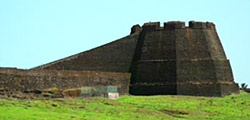Bekal is an important place of tourist interest in the district situated on the seashore of Pallikara village. It lies 12 km south of Kasargod town. According to Bekal Rama Nayak who was a local Kannada writer, the word, Bekal is derived from the word Baliakulam that means Big Palace. The term Baliakulam over a period of time got corrupted as Bekulam and later as Bekal.
In earlier days every royal palace were protected by a fort. The Bekal have existed even from early days of the Chirakkal Rajas.
 The Bekal fort is of great historical and archaeological interest. Many people from different parts of the world come to view this place. It is actually the largest and best preserved of its kind in the district and the land on which it is situated, runs into the sea with fine bay towards the south. According to the South Canara Mannual, Bekaln fort was under the province of Haider Ali in 1763. It rendered the Huzur of Canara during Tipu`s time. After the overthrow of Tipu Sultan in 1799, Bekal was incorporated into the territories of the English East India Company. The former Kasaragod taluk of South Canara district was known as Bekal for more than half a century. Thus the history of the place can be described.
The Bekal fort is of great historical and archaeological interest. Many people from different parts of the world come to view this place. It is actually the largest and best preserved of its kind in the district and the land on which it is situated, runs into the sea with fine bay towards the south. According to the South Canara Mannual, Bekaln fort was under the province of Haider Ali in 1763. It rendered the Huzur of Canara during Tipu`s time. After the overthrow of Tipu Sultan in 1799, Bekal was incorporated into the territories of the English East India Company. The former Kasaragod taluk of South Canara district was known as Bekal for more than half a century. Thus the history of the place can be described.



















